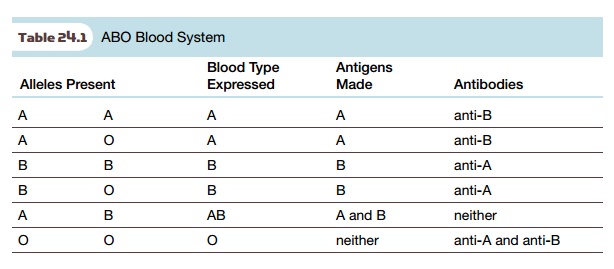Chapter: Biotechnology Applying the Genetic Revolution: Forensic Molecular Biology
Blood, Sweat, and Tears
BLOOD,
SWEAT, AND TEARS
All kinds of body tissues and fluids may
be used to establish identity. Although DNA technology is relatively new, it is
a logical outgrowth of the work on blood typing that has been used in the
courtroom for more than 50 years. Although blood analysis is most common, other
body fluids such as sweat, tears, urine, saliva, and semen also have cells with
surface proteins that can be analyzed.
The membranes of red blood cells contain
several proteins and lipids with attached carbohydrate portions that are
exposed on the outside of the cell. These are highly antigenic, and in blood
typing, they are referred to as blood antigens . Binding of an antibody to the
corresponding antigen is highly specific. Consequently, two related blood antigens
with only relatively small shape differences can be told apart because different
antibodies will bind them. Several groups of blood antigens are routinely used
in identification. The best known is the ABO blood group system. Three different
glycolipids, A, B, and O, are involved. These consist of different carbohydrate
structures attached to the same lipid. The A antigen is made by adding N -acetylgalactosamine
to the end of the O antigen, and the B antigen by adding galactose ( Fig. 24.2
). Antibodies are made against the A and B antigens, but the shorter O
“antigen” is poorly antigenic and invokes little antibody production. The
closely related enzymes that make the A and B antigens are encoded by different
alleles of the same gene. Absence of this enzyme gives the O allele.

Thus there are three alleles—A, B, and O—present
in the population. Because we all have two copies of each gene, we all have two
alleles for the ABO system. These may be identical or different in any given
person. The alleles for the A and B antigens are both dominant; therefore, if
at least one allele for either A or B is present, that antigen will be expressed
( Table 24.1 ). A person with one A and one B allele will express both antigens
on the surfaces of his or her blood
cells (AB blood group).

People do not make antibodies against those antigens present on their own red blood cells. Each individual makes antibodies against foreign antigens, that is, those present only in other individuals. Consequently, people with type A blood will express antibodies against the B antigen, whereas those with type B blood will express antibodies to the A antigen. People with type O blood will express antibodies to both A and B antigens and those with type AB have neither antibody (see Table 24.1 ). If a person is given blood of the wrong type, the person’s own antibodies cause the foreign blood cells to clump together or agglutinate. People with type AB blood are considered universal acceptors, because they will not react against any type of blood. Conversely, type O people are universal donors but can only accept type O themselves, because they have antibodies to both the A and B antigens. Because humans are diploid, a child may belong to a different blood type than either of its parents. For example, an AO mother will make A antigen and a BO father will make B antigen. Despite this, they can have a type O child, because the child may inherit the O gene on one chromosome from the heterozygous mother and another O gene from the heterozygous father ( Fig. 24.3 ).

Usually we know who the mother of a
child is. Mostly it is the father who may be difficult to identify. If you are
accused of being a father in a paternity suit, ABO typing will only exclude you
in around 15% to 20% of cases, assuming you are innocent. Consider, for example,
a mother who has blood type A with a daughter of type AB. We know the father
must have contributed the B allele to the daughter. Therefore the father must
be BO, BB, or AB but cannot be AA, AO, or OO. Therefore, anyone accused of
paternity who has type A or type O blood is innocent. Individuals with type B or
AB blood might be guilty. Because large numbers of people share each blood group,
ABO blood typing alone cannot provide proof of guilt, although it can prove
innocence.
There are several other blood and tissue
antigen systems similar in principle to the ABO system that are also used in
forensic medicine. Using the HLA system of white blood cells, the chance of
exclusion is over 90%. When the HLA and ABO systems are combined, the chances
of exclusion are about 97%. Including the analysis of blood serum proteins with
the others makes exclusion almost certain, if the accused is indeed innocent.
The following formula is used to
determine the combined probability (P) of exclusion from multiple tests with
individual probabilities P1, P2, P3, and so on:
P = 1 − ( 1 − P 1 ) ( 1
− P 2 ) ( 1 − P 3 ) ( 1 − P 4 ) etc
.
Related Topics